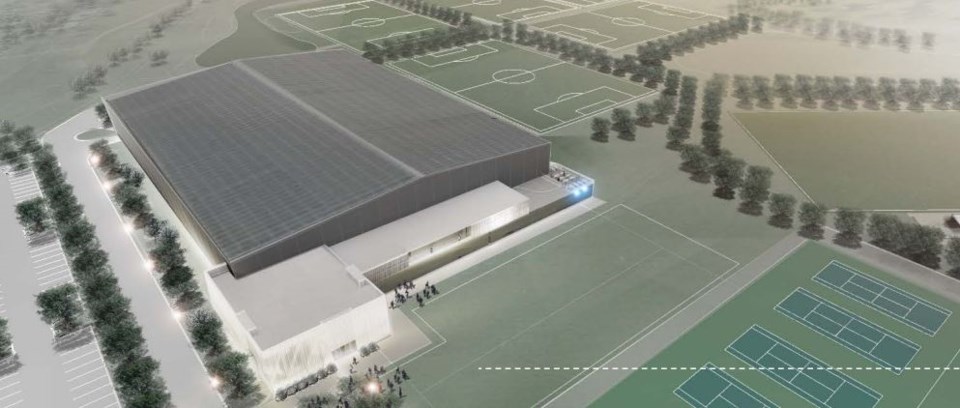THUNDER BAY – A proposed new multi-million indoor sports centre will take its first concrete step forward, though the direction to include tennis courts has been removed from city administration’s mandate.
The estimated $30-million project, which has been percolating for the last few years, passed a key checkpoint late Monday night when Thunder Bay city council voted to ratify its decision from last month to provide in-principle support.
That vote authorizes city administration to proceed with $4.25 million of preliminary work, including site investigation and engineering studies, to prepare tender documents that would advance the project to the shovel ready stage.
Indoor field turf space has been at a premium in Thunder Bay since the November 2016 collapse of the privately-operated Sports Dome. The Lakehead University Hangar and the repurposed bubble on Confederation College have served as the only two available facilities, forcing many leagues to adapt to gymnasium floors or go on a rotating hiatus.
Local soccer organizations first brought forward a proposal, which included conceptual design and a preliminary business plan, for a permanent Chapples Park facility to the previous term of city council in January 2017. Though that term of council last year declared the project a priority, there was never a firm commitment.
Though the decision does not bind the city to build the facility, Soccer Northwest president Michael Veneziale recognized Monday’s outcome as the first concrete step to get the ball rolling, though he’s keeping his hopes from getting too high.
“We’re going to try to promote the idea that this is a massive victory but until the shovel is actually in the ground, I’m going to remain worried about it,” Veneziale said.
“I love the fact that we can move forward with this step but we’re going to continue to do everything we can to make it happen, including fundraising efforts. We want to make sure this happens. It’s not just for the soccer community that I’m representing but it’s really for the community.”
The discussion on Monday largely looked ahead to the decision down the road of whether to construct the facility, rather than just the commitment to do the planning.
Coun. Andrew Foulds (Current River), who was around during the city’s ill-fated event centre pursuit, argued that project’s unsuccessful outcome shouldn’t deter council from trying again.
“I don’t think we should let past decisions render this council impotent or fearful of making another big decision,” Foulds said.
“The $3.6 million we spent on the event centre – half from municipal, half from other – do I wish we had put that into roads and not into those studies? Of course, I do but we had to do that work to get us ready to make another decision. We have to do this work to get to this other decision.”
Coun. Mark Bentz (At-Large), who ended up being the only dissenting vote, said he supports the overall project but questioned the urgency and lack of definitive answers.
“We’re really putting the cart before the horse here. We’re actually trying to decide if we’re going to move forward with a project before we have the answers on funding, on who our partners are, how the tennis club might contribute, how the soccer club might contribute,” Bentz said.
“I’ve never seen anything like it. This would be one of the largest projects that we embark on in a very long time if we are not successful in getting funding.”
Mayor Bill Mauro said the city could put forward as much as $15 million without raising taxes, between the $4 million already directed into a standalone indoor turf reserve fund, nearly $7 million from the federal government’s one-time enhanced gas tax funding and future municipal accommodation tax revenue.
"I hear people say we don't have the money, I always think you do so have the money. You just have to decide how you want to spend it," Mauro said.
Coun. Peng You (At-Large), despite ultimately voting in favour of proceeding, urged the soccer and tennis communities to step up to develop a project without relying on the city and called for a plebiscite.
“If taxpayers say no, that means no,” Peng said.
Mauro said going down the plebiscite path would be easy but admitted many city residents might oppose the project.
“My expectation would be it would lose. Just a guess,” Mauro said. “There’s lots of people that aren’t going to be happy with it but those are probably the same people, maybe, that didn’t want an art gallery, who didn’t want the community auditorium, who didn’t want a new hospital.”
Council last month had decided in June to include a provision for six indoor tennis courts in the first phase of the project, which administration estimated could add as much as $9 million to the final price tag.
Mauro successfully lobbied his colleagues to remove that addition from administration’s mandate, instead directing the direction on whether to include court racquet sports to a special purpose committee that will be struck.
“My commitment would be as a member of the sub-committee that it be included in phase one. I’m not looking to exclude it,” Mauro said, explaining the contentious nature of the decision requires a more extensive exploration.
“This is not to stop tennis.”
Council is expected next week to formalize the establishment of that committee, selecting its members and approving its terms of reference.
